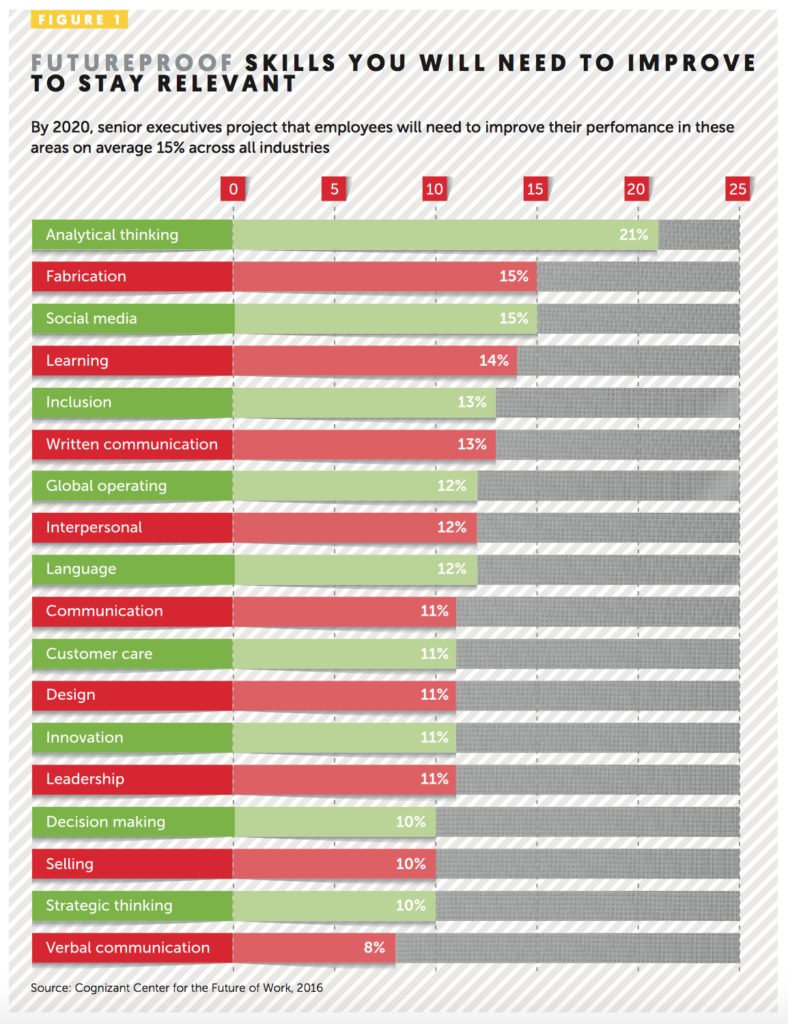The new machines, powered by AI, won’t lead to a job apocalypse, and they may even set humans free, writes Paul Roehrig
[button type=”large” color=”black” rounded=”1″ link=”https://issuu.com/revistabibliodiversidad/docs/dialogue_q4_2017_full_book/30″ ]READ THE FULL GRAPHIC VERSION[/button]
Get fit! Stop smoking! Transform your business! Success with any meaningful change begins with a simple question: “Where do I start?”
From our work with business leaders all over the world on how to compete using our new digital machines, we found that “where do I start?” is probably the most common query of our modern business age.
In these days of ‘all things digital’, your work life probably seems more packed with questions than answers. When machines do more of nearly everything, what will you do? Will a robot take your job away? Will your company be ‘Amazoned’? What will your industry look like in five years? Will your children be better off than you are?
By now, many clearly recognize that AI is already all around us. In fact, it’s at the core of experiences many of us have every day. It’s how we book a car through Lyft, arrange a hotel room through Hotel Tonight, or engage with Alexa to play the music we want. A budget video camera guide professes that AI has proliferated so much that it forms the base for the development of pictures in digital cameras.
What’s beginning to happen, and what will accelerate over the coming years, is that AI will be applied more to work that matters – how we bank, how we heal, how we insure our families, how we educate our children.
As we explain in our recent book What To Do When Machines Do Everything, the hard truth is that the debate about digital, AI and new machines is no longer about “if” but “when?”. Endlessly wondering “where do I start?” is a surefire way to land on the career down-escalator. (Next floor: VCRs, Kodak film, and irrelevance…) If you’re still unconvinced, just ask the recently departed C-suite occupants from Ford, GE and Uber (or Blockbuster, Yahoo, BlackBerry), who have not met digital economy expectations.
This may all sound a bit dire or alarmist, but before you reach for a breakfast martini, keep in mind that the good news is that digital means growth! We surveyed 2,000 C-suite executives from retail, banking, insurance (health and P&C), manufacturing and life sciences – with a combined total revenue of about $7.3 trillion – and found that the impact of digital transformation on these industries between 2015 and 2018 alone could be up to $20 trillion.
In a business world moving at the speed of Google and growing at a Moore’s Law pace, “where do I start?” becomes an existential question for each of us. Getting it right is the great opportunity of our time. Fortunately, the early winners of the digital economy are already beginning to show a practical path to get started. Here are three things you can do immediately to become fit for the future:
To become more digital, focus on humans
It may sound counterintuitive, but in a world of more pervasive technology, activities that humans do well will become even more important. Analytical, communication and learning skills, as well as the ability to relate to other people, have all been vital for business success throughout history. But in the coming years, these very human traits – things we do naturally, but computers struggle with – will become even more essential. The data clearly shows that distinctly human job skills – the ability to engage with others, lead, ask questions, reason, and interpret – will dramatically increase in importance.
You might think: “Hang on! I saw a robot on CNN that could dance/sing/drive/pick strawberries/whatever… What about robots doing more human stuff?” Yes, machines will do more and more, but the people building the new machines will tell you that fears about robots replacing all human knowledge work overnight is largely indicative of the hysteria that accompanies every major shift in technology. (As a society, we have been worried about new technologies impacting society since the invention of the written word, which even Socrates was against).
Being able to apply judgment, curiosity, creativity and the human touch are all far outside the purview of current and near-future technologies, and this will remain the case for some years to come, even as the new machines become more capable.

Enhance your workforce with the new machines
Our productivity has been improved by technology since a tired Mesopotamian started using the wheel to help save his aching back 5,000 years ago. More recently, machines and software have been working with us and for us in factories for years.
Now however, software bots based on AI and machine learning are becoming more ubiquitous and powerful. When you buy something from Amazon or accept a recommendation from Netflix, you are already using automation and AI in your personal life. This very same model is now being applied to countless business processes.
The current AI fearmongers assert that robots will take over all the jobs. Some jobs will go away; there is no doubt about that. But the number is less than many people think, and the more common scenario is that workers will be enhanced with new technology to become much more productive.
The next time you walk into your workplace, think about what everyone is doing (for work, not on Facebook or League of Legends). Now imagine what your business or agency could do if 50% of your people were 50% more productive. This may sound extreme, but it can happen if you pick the right targets to enhance your workforce by automating certain routine tasks.
Consider that every knowledge work job – probably like yours – is made up of different tasks. Some tasks – probably the parts of your job you hate doing – are ripe targets for AI to take over. When you pick the right tasks to automate, the economic impact can be game-changing as the new machines improve efficiency while simultaneously freeing up workers – us – to do more and higher-value work. That means more productivity, and that’s the goal.
Blue Prism, for example, is saving companies millions of pounds a year by applying AI to risk management, fraud detection and claims processing. TriZetto helps healthcare insurer clients apply process automation to improve throughput, accuracy and cost. The list goes on and on, and will continue to grow as applying AI to work becomes a new business imperative.
So where to start? The first and most important step is to pick your spots. This will vary by business of course, but there are some common themes you should look for. (If you want a shortcut, look for a cubicle farm where lots of people are doing the same thing over and over and over again.)
Software robots don’t get bored, so start with work that is highly repetitive and done by lots of people (because you want a meaningful impact). Robots are great at calculations, so tasks that rely heavily on a prescribed process and large amounts of data are far better targets for automation. Avoid trying to automate complex, ambiguous work that requires intuition, empathy, curiosity, insight or judgment. In spite of all the sci-fi talk, it’s best to leave that work to us humans.
The key here is to pick your spots. Apply AI systems to automate specific (often mundane) tasks, and use that freed-up time and energy to do higher-value work. This higher-value work is often what we much prefer doing to completing forms (again), expense reports (always behind), scheduling (just a mess), and managing your endless soul-crushing daily tsunami of emails.
Make everything a code generator
You know something serious is happening when it shows up in bad jokes. “What will my refrigerator say to my sprinkler system?” “My alarm system got hacked and is demanding a Bitcoin to turn off.” Not funny, and the point is serious business. Every thing can now be a code generator. Watches, appliances, shirts, lightbulbs, cars and medical devices are now instrumented with sensors. More importantly, businesses are creating new products and services based on this data.
Where to start instrumenting? The better question is where should you not? Selling or servicing mortgages? Instrument the home to help prevent predictable damage. Retail? Use sensors to better track and manage foot traffic and product placement. Healthcare? Instrument your ICU to help improve health outcomes. Manufacturing? Every machine should now be sending out data to improve productivity and uptime.
With the cost of chips and sensors continuing to drop, every physical thing should be generating valuable data that your business or agency can use. The only limit is your creativity and willingness to innovate.
Once you have data coming off a lightbulb, shirt, windmill or pet collar, what do you do with it? What are the correlations hidden in the data? How can you monetize the data from your table or car? It’s not really just specific physical items either. Your logistics process, call centre or claims process should also be generating data.
Many leaders get a bit paralyzed here, because they don’t recognize fully that data is a means, not an end. It’s a raw material, not a business outcome. This is why you need support from your analytics team to help unlock value from your new raw material.
Data science and algorithm building is not alchemy or a black art, it’s merely a set of tools that curious people can use to draw meaning and insight from data. If you don’t have these tools wielders next to you, and many leaders may not, then one of the most important things you can do to get fit fast is build a network of partners who can help you make meaning – and business value – from your data. Then it’s up to your business team to build new business models, consumer experiences and products based on your insights.
A postcard from your future
It’s a cliché but also true: this is all easier said than done. But similar to healthy eating and fitness habits, becoming digital should be the new practice for everyone hoping to succeed in the coming quarters and years.
In five years’ time, the business landscape will be very different. New players will emerge. Venerable companies will fall. Unimagined technologies will exist. Anyone with too much certainty about how the future will play out is selling something. But we know enough to get started, and we must get started.
We also know the clock is ticking. (Digital clocks don’t actually tick, but you get the idea.) If you act soon, this is going to be great. But if you don’t, your advantage will wither.
After years of meeting people building new AI-fuelled systems of intelligence, one common thing that struck us was their sense of optimism. These weren’t Pollyannas or naive children, they were successful business people working hard to do the right things for their customers and their companies. They were probably like you.
And that’s the point. Winners of the fourth industrial revolution will not sleep through the starting gun. They will recognize that waiting is the highest risk, decide that they had the agency to take an action, refuse to be stonewalled by perceived roadblocks, and then take the first steps described here to get fit for the future
of work.
— Paul Roehrig is a cofounder and chief strategy officer of Cognizant Digital Business. He is a coauthor – along with Malcolm Frank and Ben Pring – of What To Do When Machines Do Everything
[button type=”large” color=”black” rounded=”1″ link=”https://www.linkedin.com/groups/5125875″ ]JOIN THE CONVERSATION[/button]

